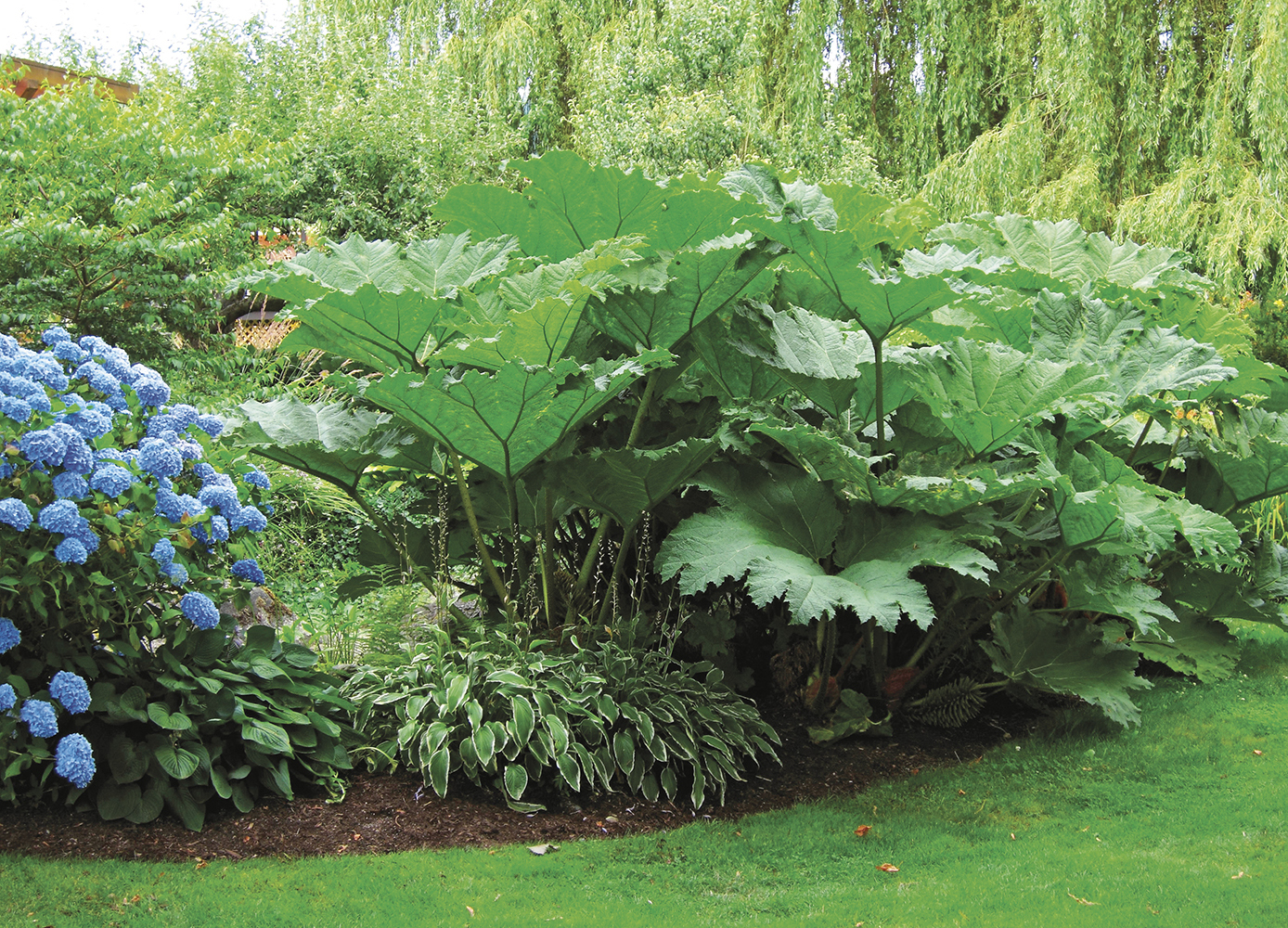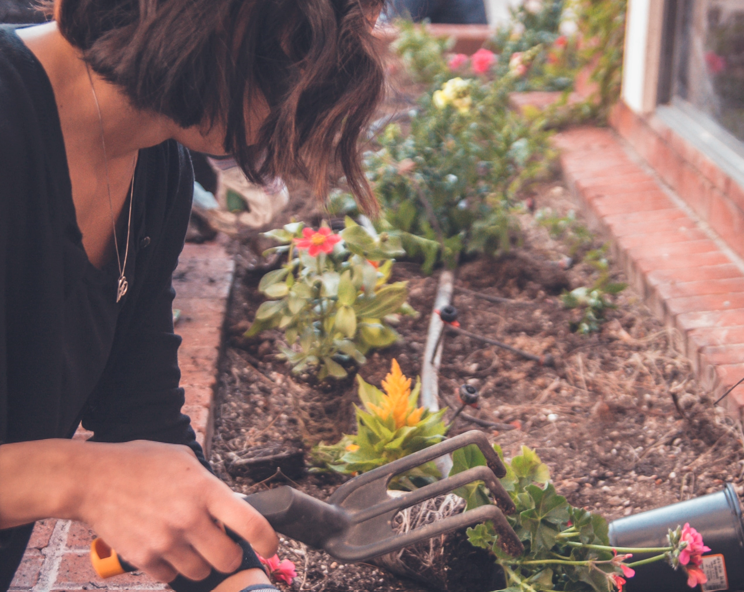To find out exactly what a plant needs from you, just check out its leaves
By Carol Hall
It’s tempting to plant these beauties in whatever design pleases the eye, as if arranging cut flowers in a vase, but unusual foliage always has its own reasons for looking unusual. To do these plants justice, it’s vital to understand what their leaves are telling us.
Big Leaves
Plants with really big leaves, such as ligularias (Ligularia species, hardy to -40°C/F), yellow waxbells (Kirengeshoma species, to -29°C/-20°F), and umbrella plants (Darmera peltata, to -35°C/-30°F), need rich soil, protection from wind, and a combination of shade, cool temperatures, and regular moisture. So do tender big-leaved plants such as calla lilies (Zantedeschia species) and caladiums (Caladium species).
If only one site requirement is inadequate, the others can sometimes compensate. For instance, calla lilies will grow in soil of average moisture if the site is shady enough, and ligularias will survive heat and sun if given enough moisture. Even giant gunnera (Gunnera manicata, to -18°C/0°F) will take full sun on the cool-summer West Coast, but only if planted beside a pond to supply the necessary constant moisture.
Spiky Leaves
Plants with spiky leaves also appreciate fertile soil, but their other preferences couldn’t differ more from those of big-leaved plants. Plants such as Adam’s needle (Yucca filamentosa, to -29°C), red-hot pokers (Kniphofia species, to -29°C), crocosmias (to -29°C), and frost-tender species such as gladioli and dracaenas need full sun and excellent drainage. Average soil moisture is fine when it’s hot or when plants are blooming (or both), but none of these species will take prolonged periods of soggy soil, and standing water can be fatal.
Leathery Leaves
Plants with leathery evergreen leaves, like those of rhododendrons, are born survivors in milder climates, where they’re reliably drought tolerant in partial shade to cool sun. Other leathery-leaved plants include bergenias (Bergenia species, to -45°C/-50°F), hellebores (most to -29°C), laurels (Prunus species, most to -23°C/-10°F), mahonias (to -29°C), sweet box (Sarcococca species, to -23°C), hollies (to as low as -35°C), and leatherleaf viburnum (Viburnum rhytidophyllum, to -29°C). As long as they’re protected from intense sun, strong winds (both hot and cold), and prolonged drought, such plants will survive almost anything within their hardiness range.
Succulent Leaves
Not surprisingly, succulent leaves indicate exceptional drought tolerance: their purpose is to store water. Plants such as evergreen stonecrops (Sedum species, most to -45°C) are very adaptable, tolerating full sun, considerable shade, dry soil, moist soil (as long as it’s fast draining), and even total neglect. So do fleshy-leaved evergreen euphorbias such as donkey-tail spurge (Euphorbia myrsinites) and purple wood spurge (E. amygdaloides ‘Purpurea’, both to -29°C). Taller-growing deciduous sedums that bloom in the fall, such as ‘Autumn Joy’ (to -45°C), are only slightly less drought tolerant.

Royal Purple smoke tree.
Coloured Foliage
Burgundy, maroon, or dark-purple foliage needs considerable sun and will turn green in too much shade. However, sun isn’t the same as intense heat or prolonged drought, which can cause leaf scorch: coloured foliage also needs average water and reasonably moderate temperatures. Good dark-leaved specimens include red Japanese maples (to -29°C), Crimson King Norway maple (Acer platanoides ‘Crimson King’, to -35°C), Forest Pansy redbud (Cercis canadensis ‘Forest Pansy’, to -23°C), Diabolo ninebark (Physocarpus opulifolius ‘Diabolo’, to -40°), and Royal Purple smoke tree (Cotinus coggygria ‘Royal Purple’, to -29°C), along with dark-foliaged elderberries (Sambucus species), weigelas, and flowering crabapples (all to -35°C). Most also thrive in light or dappled shade, and finer-foliaged specimens such as red cut-leaved Japanese maples require some protection from intense sun and hot or cold winds.
Golden-foliaged plants need high light levels (they, too, turn green in shade), but tend to scorch in full sun. Their best sites are filtered shade, morning sun plus afternoon shade, and shade from midday to mid-afternoon. Regular to ample water is needed, especially in hot spells. Specimens with relatively good sun tolerance include Sutherland Gold elderberry (Sambucus racemosa ‘Sutherland Gold’, to -40°), Golden Princess spirea (Spiraea japonica ‘Lisp’, to -35°C), Tiger Eyes staghorn sumac (Rhus thyphina ‘Bailtiger’, to -35°C), Baggesen’s Gold box honeysuckle (Lonicera nitida ‘Baggesen’s Gold’, to -23°C), and Golden Spirit smoke tree (Cotinus coggygria ‘Ancot’, to -35°C). Many other shrubs, perennials, conifers, and ornamental grasses also feature beautiful golden foliage.
There’s a fine line between golden and lime-coloured foliage, especially in medium shade or later in the season as leaves mature, but truly lime-coloured foliage, such as that of tender ornamental sweet potato vines, seems to be slightly more sun and heat tolerant. Either colour is superb in partially shaded sites.
Whether white-edged, yellow-edged, or marbled, plants with variegated foliage appreciate protection from intense sun but are otherwise quite adaptable. Although slightly less hardy than their green-leaved counterparts, variegated lily-of-the-valley shrubs (Pieris japonica cultivars, to -29°C), boxwoods (Buxus species, to -23°C), hostas (to -45°C), and shrub dogwood (Cornus alba ‘Elegantissima’, to -40°) are admirably drought tolerant in partial to full shade, where they literally shine.
Silver-variegated plants such as lungworts and lamiums are also best in partial shade, but all-grey foliage, especially if it’s fuzzy, needs full sun and light-textured, very well-drained soil. Plants such as lamb’s ear (Stachys byzantina, to -40°), rose campion (Lychnis coronaria, to -40°), silver sage (Salvia argentea, to -29°C), butterfly bush (Buddleja davidii, to -29°C), woolly thyme (Thymus pseudolanuginosus, to -45°C), and dusty miller (Centaurea cineraria, hardy to -18°C but usually used as an annual) excel in dry sunny sites, even on infertile soil, but can’t abide wet feet, especially in winter.
Startlingly blue foliage, such as that of Colorado blue spruce (Picea pungens Glauca Group, to -45°C) and blue fescue (Festuca glauca, to -40°), is actually blue-green, but a covering of minute fuzzy white hairs makes it appear blue. These plants also need full sun and excellent drainage, and thrive best in low rainfall areas: constant rains mat the tiny white hairs and make the foliage appear darker and greener. However, smooth blue-green foliage like that of some hostas can take shade and moisture without losing their looks.
Photos: Carol Hall.
Giant gunnera.





